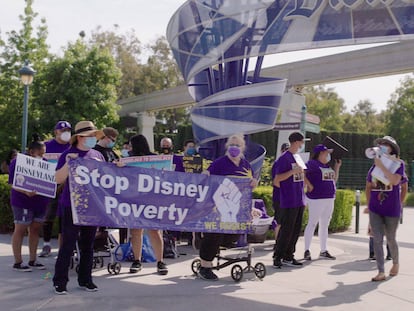‘Strange World’: Disney finally features a gay couple as protagonists
In the animated film, a teenager tells his father that he is in love with another boy

When Lightyear was released just two months ago, the conversation centered on a same-sex kiss between two female characters. In the scene, which caused great controversy and saw the movie banned from several countries, two women in a long-term relationship give each other a welcoming, loving and chaste kiss, after one of them returns from space.
In these times, this should be considered completely normal. But the scene sparked debate due to two issues: Florida’s controversial “Don’t Say Gay” law, which prohibits any class discussion about sexual orientation and gender identity to students younger than nine years old, and Disney’s efforts as a company to have it repealed. The Lightyear kiss remained for a while in a drawer in the editing room. It had been destined for the cutting room floor, until the protests of Disney employees forced it back into the final version.
Disney’s new animated movie Strange World, co-directed by Don Hall and Qui Nguyen, once again has sparked a debate about sexual orientation. This time, the topic appears on a much larger scale: one of the protagonists, a teenager, is in love with another boy. He tells his father about it. His father supports him and gives him advice, not focusing on whether his son is gay or not, but simply as a father who is by his son’s side in matters of love. That is to say, the film completely normalizes the fact that a boy may feel attracted to or love another person of the same sex, along the same lines as, for example, the movie Call Me By Your Name by Luca Guadagnino, which also refrained from turning sexual orientation into the center of family conflict.
Some reviewers have criticized the fact that the boys in Strange World do not share an onscreen kiss. But that is irrelevant in light of the naturalness with which the film presents the relationship. For Disney, it’s a historic gesture.
Narratively, the film is a classic adventure that echoes Jules Verne’s novel Fantastic Voyage and the 1987 sci-fi movie Innerspace. It provides interesting subtext about generational differences: a tough grandfather, brave in the face of any threat; a practical father who provides solutions for everything; and a grandson, the teenage boy, who flees from conflict and goes through life armed with a uniquely contemporary idealism. That idealism also plays out in one of the key sequences, in which the three of them are playing a board game. While the grandfather and father insist that there must be a villain, the grandson wonders why there must always be a bad guy. Is this fallacy or naïveté?
Unfortunately, Hall and Nguyen fail to create an attractive new universe to live up to the title. The color combinations of fuchsias, greens and blues are not appealing. The story shares the same message about environmentalism as much of children’s media today. But the main problem with the adventure itself is that the living organism where they live, and the immune system that accompanies it, is described in such a cumbersome way that is difficult for viewers to understand.
This Christmas, Disney threw its support behind an idealistic world, the LGBT+ friendly and villain-less. It is not a small feat. But it misses what is essential in a film: a well-told story.
Tu suscripción se está usando en otro dispositivo
¿Quieres añadir otro usuario a tu suscripción?
Si continúas leyendo en este dispositivo, no se podrá leer en el otro.
FlechaTu suscripción se está usando en otro dispositivo y solo puedes acceder a EL PAÍS desde un dispositivo a la vez.
Si quieres compartir tu cuenta, cambia tu suscripción a la modalidad Premium, así podrás añadir otro usuario. Cada uno accederá con su propia cuenta de email, lo que os permitirá personalizar vuestra experiencia en EL PAÍS.
¿Tienes una suscripción de empresa? Accede aquí para contratar más cuentas.
En el caso de no saber quién está usando tu cuenta, te recomendamos cambiar tu contraseña aquí.
Si decides continuar compartiendo tu cuenta, este mensaje se mostrará en tu dispositivo y en el de la otra persona que está usando tu cuenta de forma indefinida, afectando a tu experiencia de lectura. Puedes consultar aquí los términos y condiciones de la suscripción digital.
More information
Archived In
Últimas noticias
Alain Aspect, Nobel laureate in physics: ‘Einstein was so smart that he would have had to recognize quantum entanglement’
Imelda Castro, the woman who wants to rule the cartel battleground of Sinaloa
The new victims of the Republican war on Obamacare: Millions hit by soaring health insurance premiums
A country divided on migrant rights: Some US states expand protections while others restrict them
Most viewed
- David King, chemist: ‘There are scientists studying how to cool the planet; nobody should stop these experiments from happening’
- Reinhard Genzel, Nobel laureate in physics: ‘One-minute videos will never give you the truth’
- Oona Chaplin: ‘I told James Cameron that I was living in a treehouse and starting a permaculture project with a friend’
- Sinaloa Cartel war is taking its toll on Los Chapitos
- Mexico completes its trade shift with the entry into force of tariffs on China and countries without trade agreements











































